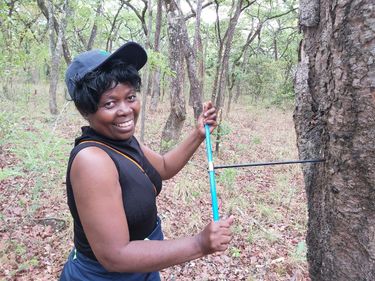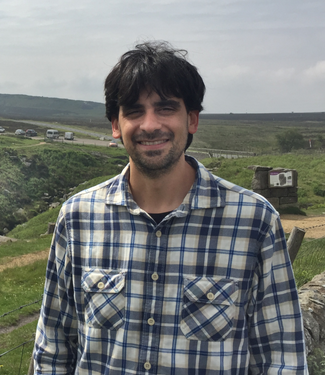
Sessions in which Jelena Lange participates
Thursday 30 June, 2022
Treeline ecotones at high latitudes and high elevations are generally temperature-limited environments. However, there is evidence that temperature control on tree growth has recently decreased at treelines due to climate change, while water availability is increasingly reported as a seasonally important growth-limiting factor. Analyzing climate-growth responses at intra-annual (wood cell) level can help unravel these complex patterns, but long time series of wood formation data are often ...
Sessions in which Jelena Lange attends
Monday 27 June, 2022
MAIDENiso is a numerical process-based model that allows researchers to simulate the growth of a virtual tree. Using daily meteorological data, the model simulates the physical and physiological processes taking place in the tree and its environment, to produce daily and yearly outputs comparable to dendrological observations. The model has been adapted and used successfully in boreal regions in North America. In an inverse mode, tree-ring obs...
Meet colleagues and friends in an informal settingFree drinks for all!
Tuesday 28 June, 2022
Africa is faced with a number of challenges including climate change and ecological disturbance due to various anthropogenic activities. These problems adversely affect the forests and also ecosystem services. My appreciation for the forests motivated me to pursure my undergraduate studies in Forestry. I first applied dendrochronology during my PhD research which focused on understanding the climate change vulnerability of the Zambezi teak forests in Zambia. However, lack of research facil...
Climate change poses an existential threat to trees, given our understanding of the importance of climate in shaping their geographic distributions. Climate envelope models are commonly used to predict how species will respond to climate change. These models give rise to the leading edge-trailing edge paradigm for range change: populations at the cool edge of a species’ distribution are expected to benefit from warming, whereas populations at the warm edge are expected to decline. We chall...
During the 21st century, the boreal biome has warmed at rates 3-4 times the global average, impacting forests directly through changes in temperature and precipitation and indirectly through acceleration of disturbances including permafrost thaw and wildfire. Despite this, little is known about the ability of boreal trees to adapt in the face of such rapid environmental changes. Warming-induced growth rate increases are predicted for the boreal biome, but these would be largely dependent o...
We present a 211-year tree-ring-based reconstruction of the annual mean flow of the Sainte Anne River, Gaspésie, Québec, Canada. The river traverses through the interior of the Gaspé Peninsula where the instrumental hydrological and climatic records are particularly short. This is the first streamflow/soil moisture reconstruction between the Hudson River and north-central Québec, filling a substantial geographical gap along the eastern North American margin, and adding to the only three ex...
Evidence of volcanic cooling and its human impacts has been described for various regions of the globe over the past several centuries to millennia, derived from paleoclimatic and historical data. Due to its remote location, detailed accounts of such impacts over Northwestern North America (NWNA) are still quite limited. Here we use a newly expanded tree-ring density network (derived from blue intensity as well as maximum latewood density parameters) to assess the climatic and human impact...
The spatial scale of climate fluctuations, or effective spatial degrees of freedom (ESDOF), depends on the timescale and the forcing: while local scale variability between far away locations may be independent on short timescales, they may become coherent over sufficiently long timescales, or if they are driven by a common forcing. While ESDOF have been estimated from instrumental data over the historical period and climate model simulations, it remains difficult to perform such analysis o...
The past and future of forests are unequivocally controlled and determined by global climate. Constraining the uncertainties within this multifaceted relationship has been the focus of vast research efforts. A spatial perspective, however, is often neglected. Using the geographical constraints (e.g. latitude, altitude) and climatic drivers of tree dynamics as a benchmark, we address the spatial patterns and changes of forest growth at a continental scale and quantify the forest growth resp...
Models of tree growth responses to climate variability provide insight about the potential effects of global warming on forests. Using a unique dataset containing tree ringwidth measurements from all trees (>4 cm in diameter at breast height) in 1ha plots, we modelled time series of annual basal area increment (BAI) in subalpine forests of western Canada, which are expected to be highly sensitive to the effects of global warming. Our objective was to determine how BAI responses to inter...
Tree-ring research has given generations of scientists a long memory of what is acceptable for a tree to be included for data analysis. The established criteria, however, were set through purposeful goals to maximize the response for climatic reconstructions. Ecology is different. Tree-rings are increasingly being used to study a wide swath of ecology, including the carbon cycle or the response of ecosystems to global changes. A fundamental aspect of ecology is to understand the range of r...
Dendroclimatic reconstructions play a key role in contextualizing recent climate change by improving our understanding of past climate variability. The climatically-sensitive blue intensity (BI) parameter is gaining prominence as a more accessible alternative to X-ray densitometry. Yet accurately representing low-frequency trends and high-frequency extremes using scanner-based BI remains a challenge due to color biases and resolution limitations. As part of the REPLICATE project, methodolo...
In this work we show the application of dendrochronology as an educational resource for schoolchildren and as a mean to disseminate science to society. Tree rings are popularly known in Chile due to the massive use of wood for construction, handicrafts and firewood. The visible tree rings generate a distinct, tangible and familiar curiosity in many people. “Tree-Rings as a Natural Encyclopedia of Environmental Archives” is an exhibition built as an educational project for schoolchildren, w...
In the context of climate change, more research is needed to better understand the impact of short-term environmental stressors on forest productivity. Intra-annual data provide crucial information to achieve this objective. Our project aims to determine the responses of tree growth and water status of boreal tree species (jack pine, black spruce and quaking aspen) under variable meteorological conditions and on contrasted soil surficial deposits using intra-annual measurements from dendro...
The Laacher See Eruption (LSE) ranks among Europe’s largest Upper Pleistocene volcanic events. Although its tephra deposits represent an important isochron for the synchronization of proxy archives at the Late Glacial to early Holocene transition, uncertainty in the eruption age has prevailed. Combined analysis of high-precision ring width and radiocarbon measurements from individual rings of trees that were killed during volcanic eruptions and buried by their deposits can provide eruption...
Wednesday 29 June, 2022
Dendrochronology is considered one the most precise of all the scientific dating techniques. However, it requires long sequences of tree rings and a master record for both the species and region in question. At the University of Groningen, we have been pioneering a new approach to dating that combines the precision of dendrochronology with the versatility of radiocarbon dating. It relies on the detection of spikes in the annual radiocarbon record, thought to b...
Current and projected changes in climate are estimated to be from 10 to 100 times faster than the natural adaptive capacity of trees whose generation times are long. As extreme climatic events are becoming more frequent and exert a strong selection pressure on tree populations, there is an urgent need to better characterize the genetic variability involved in the response of trees to climate. There is currently a lack of knowledge on the role of genetic variability in tolerance to climatic...
Information garnered from historical timbers and wooden artifacts (e.g. houses, barns, ships) can greatly enhance our understanding of human, ecological, and climate history, especially in regions where few old-growth forests and trees remain, tree longevity is relatively short (less than 300-400 years), and environmental conditions break down wood rather quickly, like in mesic to wet regions Over the last decade plus, the application of tree-ring techniques on woo...
The classic definition of the so-called “divergence problem” is a decoupling of temperature sensitive tree-ring chronologies from the instrumental record – expressed either as a loss or weakening in the inter-annual signal, or a divergence in trend in the recent period. Western Canada is one such area where divergence is ostensibly prevalent. However, recent observations using ring-width (RW) and latewood blue intensity (LWB) parameters challenge our views on divergence in this region: tre...
The main objective of this project is to quantify the increased productivity of Betula glandulosa Michx in Umiujaq, Nunavik, northern Quebec and evaluate how climatic and edaphic conditions influence this change. The speed at which climate change is affecting the northern ecosystems remains poorly understood and data are needed to anticipate future ecological and physiological trajectories of the vegetation. We produced a tree-ring chronology from approximately 40 specimens of Betula gland...
Spatially-resolved climate field reconstructions are ideal for analyzing spatial anomaly patterns and characterizing regional-scale trends resultant from climate change. To date, few fine-scale, spatially-resolved paleotemperature datasets exist in the Northern Hemisphere. Here, we present a 2.5x2.5o temperature field reconstruction of warm season (April-August) mean surface air temperatures, developed from a network of 130 tree-ring chronologies. In the reconstruction’s current form, stat...
We reconstructed wildfire history from fire-scars to detect the influences of climatic variability and land-use change on wildfire dynamics in the lodgepole pine (Pinus contorta var. latifolia Engelm.) forests of Jasper National Park in the Canadian Rocky Mountains. New original analyses were performed on 170 cross-section samples collected in the 1970s from 52 sites around Jasper, Alberta. The updated fire record reveals that fire occurrence was highly variable: site-lev...
Presentation of all Ameridendro2022 posters.FREE LUNCH FOR ALL ATTENDEES!
To estimate the effects of a warmer and drier future climate on mountain forests, we analyzed the climate response of radial growth of five different conifer species along elevation transects between 1070 m and the forest line near 2400 m above sea level within an inner-alpine dry valley in the LTSER area Matsch|Mazia in Northern Italy. For additional information in growth processes and tree hydraulics automatic dendrometer measurements were used. As expected, we generally observed positiv...
It has been shown that trees get older in the wet tropics, but the mechanisms behind this observation are still not clear. Literature shows that moisture could directly affect longevity by modulating physiological processes of trees. Other studies point to the potential role of water on tree size, which could indirectly affect longevity if one reconciles to the fact that the growth rate of tropical trees doesn’t differ significantly between wet and dry sites. The third group points to the ...
The use of stable isotope proxies in combination with tree-ring parameters has become a well-established tool to unravel plants’ responses to a changing environment. However, while there have been many studies on intra-annual wood formation processes, the specific details of the fractionation of stable isotopes in high-resolution time scales -knowing the exact date of fractionation- remain unknown. Such a time scale mismatch, provides obstacles to investigate the timing, sensitivity and in...
This is a mandatory (!) .... and FREE (!!) cocktail & award ceremony (!!!)(in replacement of the Banquet formula)->->->->->->->->->->->->->->->->->->After a great summer day of scientific and urban discoveries in our beloved MTL, we wish to bring together all the AmeriDendro community in one place and congratulate the TRS awardees for their remarkable achievements! -Bonsinsegna award-Fr...
Thursday 30 June, 2022
How old are tropical trees? This fundamental question has long driven the curiosity of laymen and scientists. But only recently, a great number of studies conducted by many brave dendrochronologists resulted in a significant tree-ring-based knowledge that allows us to start accurately estimating tree ages across the globe. As science goes, not only knowing the longevity of tropical trees is essential to understanding forest dynamics and its role in biogeochemical cycles, but one must also ...
In their book chapter in 2011 Gagen et al. (2011) highlighted the need for stable isotope dendroclimatology to move beyond studies that simply demonstrate ‘potential’. This symposium, more than a decade since this publication, will focus on dendrogeochemical studies that demonstrate that the field has moved beyond studies focused on ‘potential’. In particular, this session will strive to identify compelling new insights into unique aspect...
Allies have emerged as key enablers of diversity and inclusivity initiatives in the workplace, in professional associations, and in everyday life. But what is an ally? What skills are required to be an effective ally? How do we hold ourselves and our community members accountable for being effective allies? This symposium will provide a deeper understanding of what it means to be an ally and the skills to help advance allyship as individuals and as a community. Fur...




